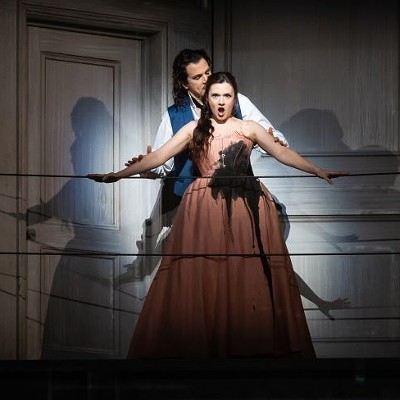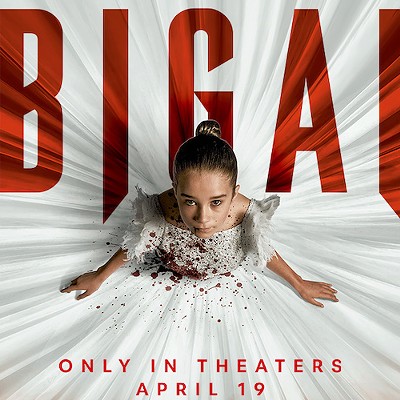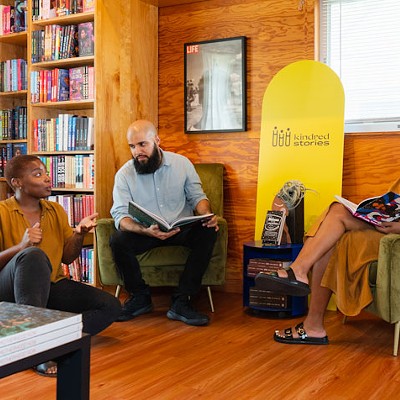Once upon a time, Houstonians who belonged to fringy subcultures and wanted to dress in ways that reflected their otherness didn't have a whole lot of options. Nowadays, any teenager with a computer or smartphone has a world of weird fashion options at his fingertips, but in the early to mid '80s, aspiring punks, goths and metalheads had far fewer resources to draw from. There were cool clothing places like Timeless Taffeta and Mr. Peabodys Way Back Machine in Montrose, and Texas Tapes N' Records out in Pasadena was a gold mine for heavy metal fans looking for cool band shirts. There were a few other record and clothing stores scattered around town that might have cool items for sale, but in the '80s, one of the main shops geared toward weird folk in search of fashion and lifestyle gear was Dream Merchant.
More than the other stores in Houston catering to young outsider types, Dream Merchant seemed to have the reputation as the place to flock to. Even punks and new wavers living out in the sticks seemed to know it was the place to go to, and I recall my amazement at discovering it for the first time, nestled in a corner upstairs in Sharpstown Mall. That location made a trip to the mall worthwhile; it was a strange outpost where a person could buy spiked belts, clothing, skull earrings and plenty of other stuff that would upset parents and high school principals. It seemed like everyone who worked at Dream Merchant was way cooler than anyone else I knew, and the shop felt like a mysterious place; entering it was more like walking into a night club than a mall clothing store.
Recently I talked to Chris O, a longtime employee at Dream Merchant during the store's '80s and early-'90s heyday. (Full disclosure: Chris O is a friend and old bandmate of mine.)
HP: How long did you work at Dream Merchant?
Chris O: "I started working at the location in Sharpstown Mall around 1985, and I worked there until about '89 or '90 or so. I can't remember exactly when we opened the store on Westheimer, but I worked there for a couple of years too."
HP: Were you one of the original employees at the Sharpstown location?
Chris: "I worked with some of the original crew, but before I started working there, it was in a different location in the mall. It was more of just a headshop downstairs at Sharpstown, and then they moved upstairs, and that's when Dee (Dream Merchant's owner) took over and started getting more clothes and things like that, instead of just bongs and stuff. I was shocked that we were allowed to sell that stuff in the mall. (Laughs.)
HP: Did you get the sense that Dream Merchant was the main underground rock lifestyle store of its kind in Houston at that time?
Chris: "We were the only place back then. There were no other places, really. Erotic Cabaret was around, but they had mostly lingerie and stuff like that; they didn't really have any other kind of clothing."
HP: What do you think made Dream Merchant stand out as special?
Chris: "The cool thing was we would go to New York twice a year to buy stuff, and that's where we'd buy unique weird stuff you couldn't find anywhere else. When I'd go to New York, I'd meet these designers, and we'd do an order. That was the badass thing about Dream Merchant; you could go there and get something that was cool as shit that you knew was one-of-a-kind. You'd pay a lot for it, it might be really expensive, but you could count on it being really high-quality stuff."
HP: Back in the '80s it seemed like finding clothes was tough if you were a punk rocker or into heavy metal or gothic music. Dream Merchant seemed like a mandatory stop if you were into those outsider genres. Besides clothing, what other stuff did the store specialize in?
Chris: "We also sold cool jewelry, clothing and gifts. We packed as much stuff into that store as we could; it was one of the few places in town where you could buy Manic Panic hair dye and things like that."
Houston Press: After the store opened the Westheimer location in the abandoned church, it seemed to have a few successful years, and then closed down, later becoming an upscale restaurant. Why, do you think, did it go out of business?
Chris: "I think it got harder to compete because more stores started opening that carried similar stuff, and in the end I think the Westheimer store moved away from the styles we'd carried successfully, and tried to go for a more high-end clothing line, which I don't think worked as well."
HP: Did you enjoy your time working at Dream Merchant? Was it a fun place?
Chris: "It was like a total family, and we'd have serious parties. The coolest thing about that job was even if you were a screw-up, Dee was going to give you a chance. It took a lot to make her fire somebody. You really had to fuck up and steal, or something. It was the coolest place to work. It was so awesome there and definitely the best place I ever worked."
Time never stops moving forward, and Houston, as well as the world, has changed dramatically over the past 20-30 years. Being a punk rocker or a goth isn't usually considered as "weird" as it was several decades ago, and finding clothing or accessories to reflect one's chosen lifestyle is simple nowadays — it certainly doesn't involve driving all over town anymore. Whether or not that's good or bad might depend on who you ask, but it's interesting to look back at stores such as Dream Merchant to remember just how special those places were.
Support Us
Houston's independent source of
local news and culture
account
- Welcome,
Insider - Login
- My Account
- My Newsletters
- Contribute
- Contact Us
- Sign out
[
{
"name": "Related Stories / Support Us Combo",
"component": "11591218",
"insertPoint": "4",
"requiredCountToDisplay": "4"
},{
"name": "Air - Billboard - Inline Content",
"component": "11591214",
"insertPoint": "2/3",
"requiredCountToDisplay": "7"
},{
"name": "R1 - Beta - Mobile Only",
"component": "12287027",
"insertPoint": "8",
"requiredCountToDisplay": "8"
},{
"name": "Air - MediumRectangle - Inline Content - Mobile Display Size 2",
"component": "11591215",
"insertPoint": "12",
"requiredCountToDisplay": "12"
},{
"name": "Air - MediumRectangle - Inline Content - Mobile Display Size 2",
"component": "11591215",
"insertPoint": "4th",
"startingPoint": "16",
"requiredCountToDisplay": "12"
}
,{
"name": "RevContent - In Article",
"component": "12527128",
"insertPoint": "3/5",
"requiredCountToDisplay": "5"
}
]
KEEP THE HOUSTON PRESS FREE...
Since we started the Houston Press, it has been defined as the free, independent voice of Houston, and we'd like to keep it that way. With local media under siege, it's more important than ever for us to rally support behind funding our local journalism. You can help by participating in our "I Support" program, allowing us to keep offering readers access to our incisive coverage of local news, food and culture with no paywalls.
Trending Arts & Culture
- Whose Story is It in The Father at 4th Wall Theatre Co.
- Love is in the Alley's Charming Production of Brontë Classic Jane Eyre
- HGO's Don Giovanni Offers Sex, Deceit and a Final Reckoning All Wrapped Up in Mozart's Music
-
Sponsored Content From: [%sponsoredBy%]
[%title%]

Don't Miss Out
SIGN UP for the latest
arts & culture
news, free stuff and more!
Become a member to support the independent voice of Houston
and help keep the future of the Houston Press FREE
Use of this website constitutes acceptance of our
terms of use,
our cookies policy, and our
privacy policy
The Houston Press may earn a portion of sales from products & services purchased through links on our site from our
affiliate partners.
©2024
Houston Press, LP. All rights reserved.




